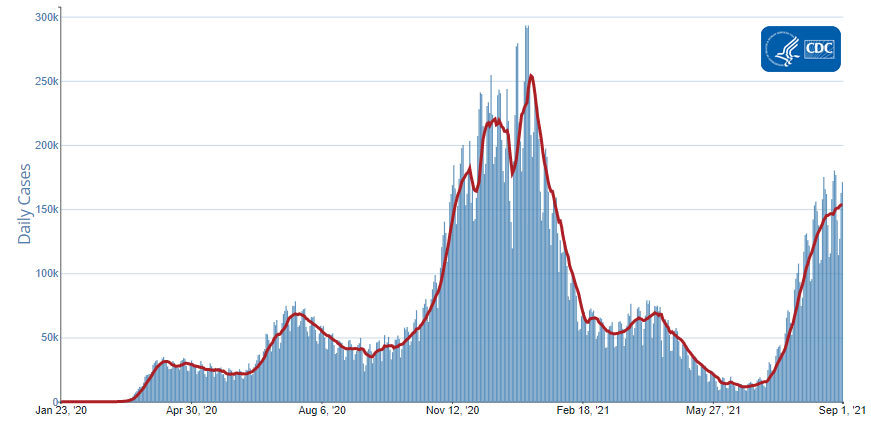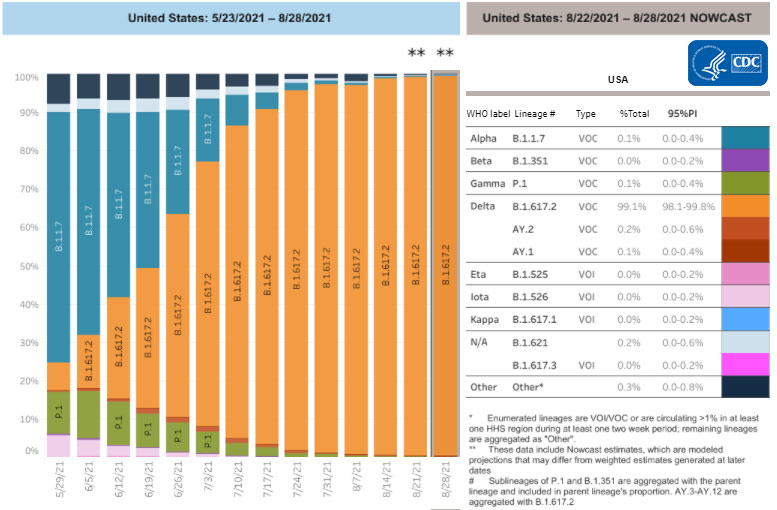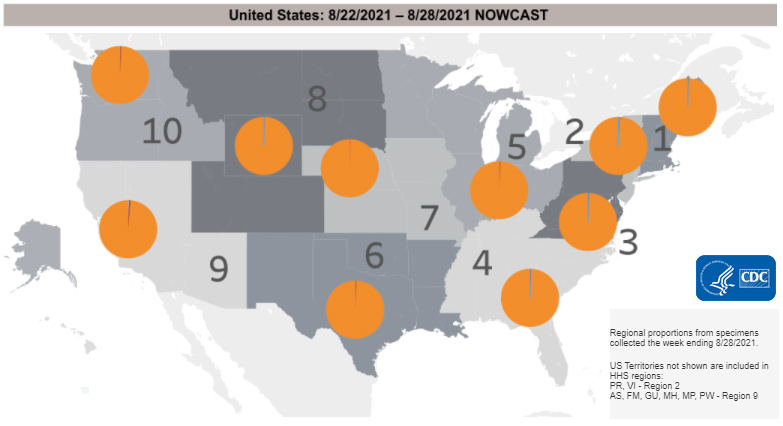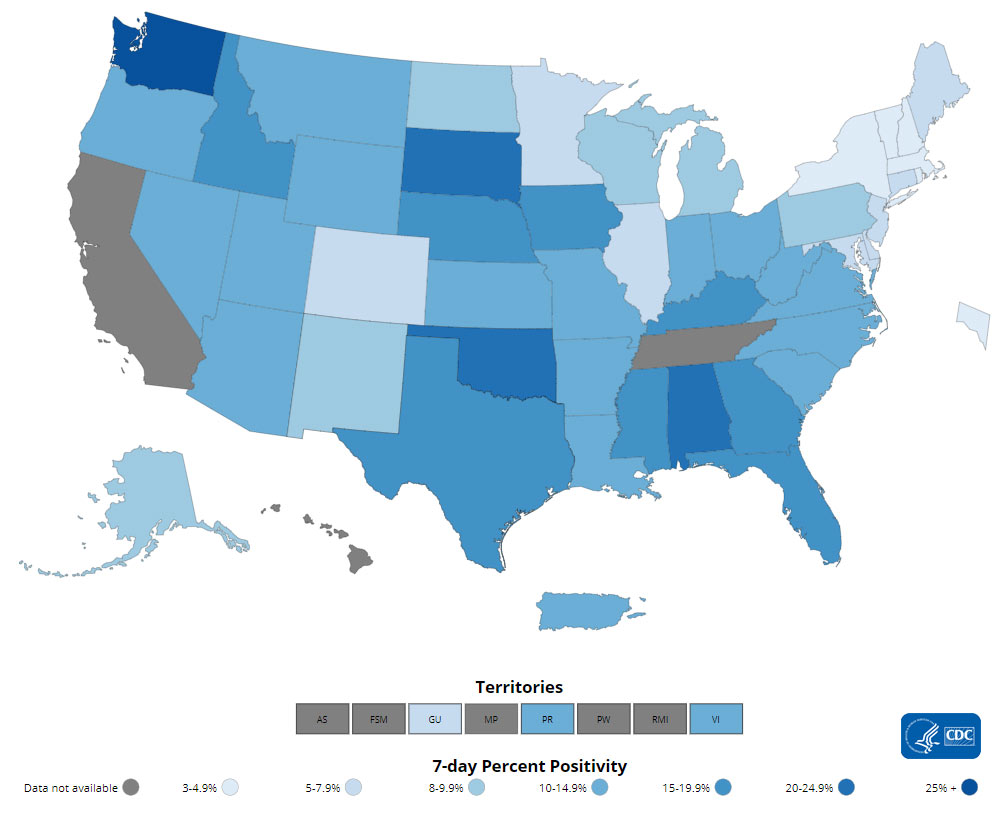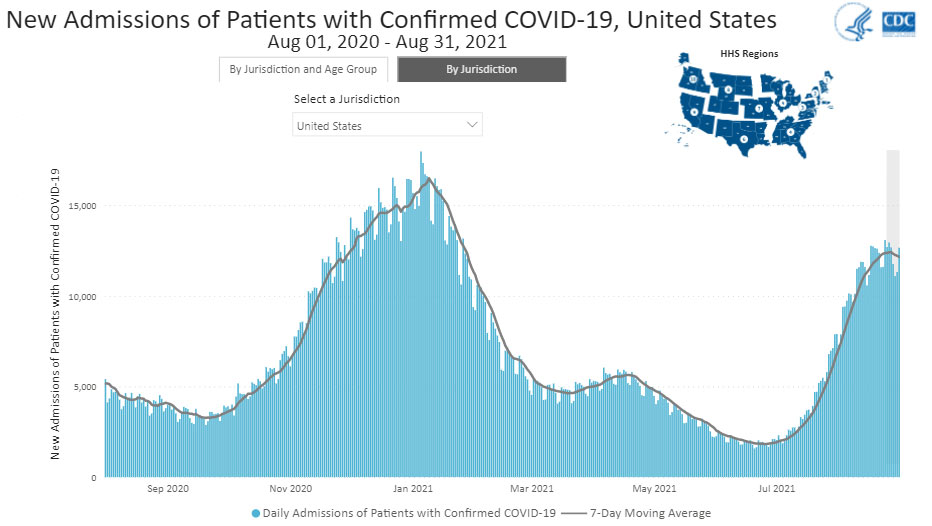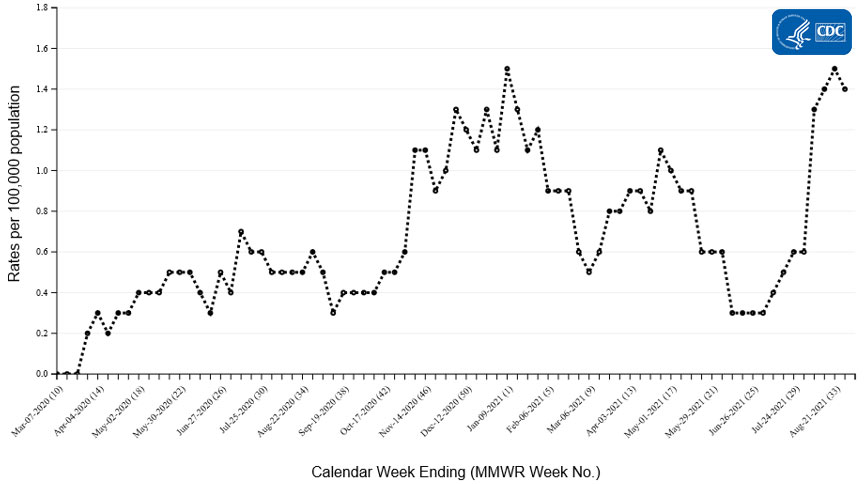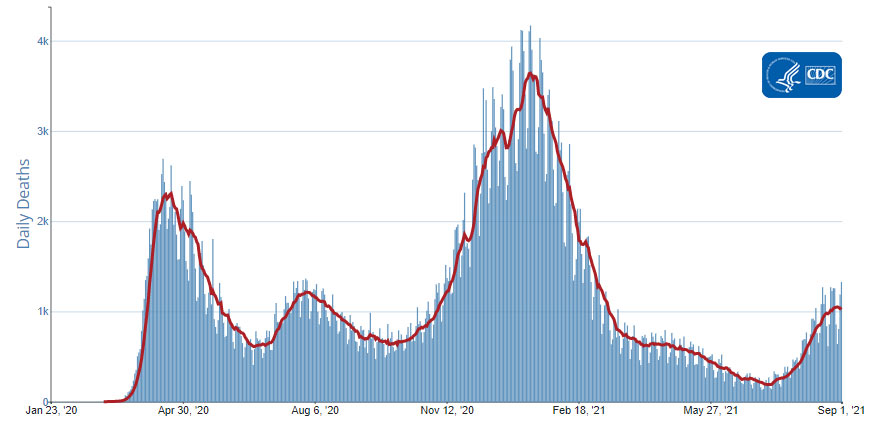Recommendations for Fully Vaccinated People
COVID-19 Homepage

Testing, Testing: School Edition
Interpretive Summary for September 3, 2021
Testing, Testing: School Edition
A recent CDC study shows that the Delta variant can spread rapidly in schools when unvaccinated teachers and staff have close, indoor contact with unvaccinated children. While children have been less affected by COVID-19 compared with adults, they can get sick with COVID-19 and can spread it to others. A second CDC study shows that rates of COVID-19-associated hospitalizations in children and adolescents increased following the rise of the Delta variant in the United States. Prevention strategies, including vaccination of school staff and eligible students, universal indoor masking, staying home when sick, and routine testing, are critical to schools reopening and operating safely.
Many people with COVID-19 don’t have symptoms but can still spread the virus. With regular testing, people can learn their COVID-19 status and use prevention measures before they spread the virus to others. This is especially important for children under 12 years old who are not yet eligible for vaccination. Finding out who has the virus early means that steps can be taken to prevent COVID-19 from spreading and causing an outbreak, which helps schools stay open. Regular testing also means parents or guardians get notified if their child tests positive, allowing them to plan for treatment and to quarantine or isolate as needed.
Safely returning to in-person instruction this fall is a priority because students benefit from learning in the classroom. Vaccination is the leading public health prevention strategy to end the COVID-19 pandemic, but children under 12 years are not yet eligible for COVID-19 vaccination. To keep school communities safe and to maintain in-person instruction, CDC recommends schools layer multiple prevention strategies. These include universal indoor masking, physical distancing, hand washing, and vaccination for all eligible people. Regular testing, in addition to other important prevention measures, will help keep students in the classroom and will allow them to participate in the other activities they enjoy.
Note to readers: CDC’s COVID Data Tracker’s new Pediatric Data page shows data and visualizations for children at the national, state, and community level. Data and maps highlighting COVID-19 trends in children ages 0-17 years can help demonstrate the impact of the pandemic on this age group. These data are important for understanding how children are affected by COVID-19. Data can also inform the actions needed to prevent the spread of COVID-19 among children and those who interact with them.
Reported Cases
The current 7-day moving average of daily new cases (153,246) increased 4.9% compared with the previous 7-day moving average (146,087). The current 7-day moving average is 123.6% higher than the value observed approximately one year ago (68,533 new cases on July 20, 2020). The current 7-day moving average is 39.7% lower than the peak observed on January 10, 2021 (253,948) and is 1,217.0% higher than the lowest value observed on June 18, 2021 (11,636). A total of 39,488,866 COVID-19 cases have been reported as of September 1, 2021.
39,488,866
Total Cases Reported
39,488,866
Total Cases Reported
153,246
Current 7-Day Average*
153,246
Current 7-Day Average*
146,087
Prior 7-Day Average
146,087
Prior 7-Day Average
+4.9%
Change in 7-Day Average since Prior Week
+4.9%
Change in 7-Day Average since Prior Week
*Historical cases are excluded from daily new cases and 7-day average calculations until they are incorporated into the dataset for the applicable date. Of 104,097 historical cases reported retroactively, 4,575 were reported in the current week and 5,042 were reported in the prior week.
Daily Trends in COVID-19 Cases in the United States Reported to CDC

7-Day moving average
SARS-CoV-2 Variants
Multiple variants of the virus that causes COVID-19 are circulating globally, including within the United States. Currently, four variants are classified as a variant of concern (VOC). Nowcast estimates* of COVID-19 cases caused by these VOCs for the week ending August 28, 2021, are summarized here. Nationally, the combined proportion of cases attributed to Delta is estimated to be greater than 99%. The national proportions of Alpha, Beta, and Gamma are estimated to be well below 0.5%. Nowcast estimates that Delta will continue to be the predominant variant circulating in all 10 U.S. Department of Health and Human Services (HHS) regions, circulating at greater than 99%. The proportions of Alpha, Beta, and Gamma are estimated to be well below 0.5% in all HHS regions.
*The median time from specimen collection to sequence data reporting is about 3 weeks. As a result, weighted estimates for the most recent few weeks may be unstable or unavailable. CDC’s Nowcast is a data projection tool that helps fill this gap by generating timely estimates of variant proportions for variants that are circulating in the United States. View Nowcast estimates on CDC’s COVID Data Tracker website on the Variant Proportions page.
*Note: Scientists monitor but may classify certain ones as variants of interest, concern, or high consequence based on how easily they spread, how severe their symptoms are, and how they are treated.
Testing
The percentage of COVID-19 NAATs (nucleic acid amplification tests)* that are positive (percent positivity) has decreased from the previous week. The 7-day average of percent positivity from NAATs is now 9.6%. The 7-day average number of tests reported for August 20 –August 26, 2021, was 1,391,645, up 4.1% from 1,336,203 for the prior 7 days.
528,875,293
Total Tests Reported
528,875,293
Total Tests Reported
1,391,645
7-Day Average Tests Reported
1,391,645
7-Day Average Tests Reported
9.6%
7-Day Average % Positivity
9.6%
7-Day Average % Positivity
10.4%
Previous 7-Day Average % Positivity
10.4%
Previous 7-Day Average % Positivity
-7.7%
Change in 7-Day Average % Positivity since Prior Week
-7.7%
Change in 7-Day Average % Positivity since Prior Week
*Test for SARS-CoV-2, the virus that causes COVID-19
COVID-19 NAAT Laboratory Test 7-day Percent Positivity by State/Territory
Vaccinations
The U.S. COVID-19 Vaccination Program began December 14, 2020. As of September 2, 2021, 372.1 million vaccine doses have been administered. Overall, about 205.9 million people, or 62% of the total U.S. population, have received at least one dose of vaccine. About 175 million people, or 52.7% of the total U.S. population, have been fully vaccinated.* As of September 2, 2021, the 7-day average number of administered vaccine doses reported (by date of CDC report) to CDC per day was 906,992, a 3.33% increase from the previous week.
CDC’s COVID Data Tracker Vaccination Demographic Trends tab shows vaccination trends by age group. As of September 2, 2021, 92.2% of people ages 65 years or older have received at least one dose of vaccine and 81.9% are fully vaccinated. Over two-thirds (74.5%) of people ages 18 years or older have received at least one dose of vaccine and 63.7% are fully vaccinated. For people ages 12 years or older, 72.5% have received at least one dose of vaccine and 61.7% are fully vaccinated.
372,116,617
Vaccines Administered
372,116,617
Vaccines Administered
205,911,640
People who received at least one dose
205,911,640
People who received at least one dose
174,973,937
People who are fully vaccinated*
174,973,937
People who are fully vaccinated*
62%
Percentage of the US population that has received at least one dose
62%
Percentage of the US population that has received at least one dose
52.7%
Percentage of the US population that has been fully vaccinated*
52.7%
Percentage of the US population that has been fully vaccinated*
+0.9
Percentage point increase from last week
+0.9
Percentage point increase from last week
+0.8
Percentage point increase from last week
+0.8
Percentage point increase from last week
*Represents the number of people who have received the second dose in a two-dose COVID-19 vaccine series (such as the Pfizer or Moderna vaccines),) or one dose of the single-shot Johnson & Johnson’s Janssen vaccine.
Daily Change in the Total Number of Administered COVID-19 Vaccine Doses Reported to CDC by the Date of CDC Report, United States

7-Day moving average
Hospitalizations
New Hospital Admissions
The current 7-day daily average for August 25–August 31, 2021, was 12,156. This is a 1.7% decrease from the prior 7-day average (12,367) from August 18–August 24, 2021.
2,759,911
Total New Admissions
2,759,911
Total New Admissions
12,156
Current 7-Day Average
12,156
Current 7-Day Average
12,367
Prior 7-Day Average
12,367
Prior 7-Day Average
-1.7%
Change in 7-Day Average
-1.7%
Change in 7-Day Average
The start of consistent reporting of hospital admissions data was August 1, 2020.
Daily Trends in Number of New COVID-19 Hospital Admissions in the United States
New admissions are pulled from a 10 am EST snapshot of the HHS Unified Hospital Timeseries Dataset. Due to potential reporting delays, data from the most recent 7 days, as noted in the figure above with the grey bar, should be interpreted with caution. Small shifts in historic data may also occur due to changes in the Centers for Medicare and Medicaid Services (CMS) Provider of Services file, which is used to identify the cohort of included hospitals.
COVID-NET: Trends in Hospitalization Rates in Children and Adolescents Aged <18 Years
CDC’s Coronavirus Disease 2019-Associated Hospitalization Surveillance Network (COVID-NET) shows that rates of COVID-19-associated hospitalizations have risen rapidly for children and adolescents younger than 18 years old. Weekly rates of COVID-19-associated hospitalizations per 100,000 children and adolescents younger than 18 years old increased nearly five-fold, from 0.3 during the week ending June 26, 2021, to 1.4 during the week ending August 14, 2021. The sharpest increase during this period occurred among children aged 0-4 years, for whom the rate per 100,000 children during the week ending August 14, 2021 (1.9) was nearly 10 times that during the week ending June 26, 2021 (0.2).
Additional information on COVID-19-associated hospitalizations in children and adolescents younger than 18 years old can be found in a new report using COVID-NET data here.
Trends in Hospitalization Rates in Children and Adolescents Aged <18 Years
The Coronavirus Disease 2019 (COVID-19)-Associated Hospitalization Surveillance Network (COVID-NET) is an additional source for hospitalization data collected through a network of more than 250 acute-care hospitals in 14 states (representing ~10% of the U.S. population). Detailed data on patient demographics, including race/ethnicity, underlying medical conditions, medical interventions, and clinical outcomes, are standardized case reporting form.
Deaths
The current 7-day moving average of new deaths (1,047) has increased 3.7% compared with the previous 7-day moving average (1,010). The current 7-day moving average is 13.8% lower compared to the peak observed on July 31, 2020 (1,214). The current 7-day moving average is 71.3% lower than the peak observed on January 13, 2021 (3,644) and is 449.7% higher than the lowest value observed on July 10, 2021 (190). As of September 1, 2021, a total of 641,725 COVID-19 deaths have been reported in the United States.
641,725
Total Deaths Reported
641,725
Total Deaths Reported
1,047
Current 7-Day Average*
1,047
Current 7-Day Average*
1,010
Prior 7-Day Average
1,010
Prior 7-Day Average
+3.7%
Change in 7-Day Average Since Prior Week
+3.7%
Change in 7-Day Average Since Prior Week
*Historical deaths are excluded from the daily new deaths and 7-day average calculations until they are incorporated into the dataset by their applicable date. Of 7,169 historical deaths reported retroactively, 227 were reported in the current week and 154 were reported in the prior week.
Daily Trends in Number of COVID-19 Deaths in the United States Reported to CDC

7-Day moving average
- Epidemiologically Linked COVID-19 Outbreaks at a Youth Camp and Men’s Conference — Illinois, June–July 2021
- Association Between COVID-19 and Myocarditis Using Hospital-Based Administrative Data — United States, March 2020–January 2021
- COVID-19 Vaccination Coverage Among Adolescents Aged 12–17 Years — United States, December 14, 2020–July 31, 2021
- Outbreak Associated with SARS-CoV-2 B.1.617.2 (Delta) Variant in an Elementary School — Marin County, California, May–June 2021
- COVID-19 Case Rates in Transitional Kindergarten Through Grade 12 Schools and in the Community — Los Angeles County, California, September 2020–March 2021
- Multiple Variants of SARS-CoV-2 in a University Outbreak After Spring Break — Chicago, Illinois, March–May 2021
- National, Regional, State, and Selected Local Area Vaccination Coverage Among Adolescents Aged 13–17 Years — United States, 2020
- Screening Programs for SARS-CoV-2 Infections on a University Campus — Austin, Texas, September 30–November 30, 2020
- Hospitalizations Associated with COVID-19 Among Children and Adolescents — COVID-NET, 14 States, March 1, 2020–August 14, 2021
- Trends in COVID-19 cases, emergency department visits, and hospital admissions among children and adolescents aged 0-17 years — United States, August 2020–August 2021
Recent COVID Data Tracker Updates
- A new Pediatric Data page catalogs all pediatric data available on COVID Data Tracker and provides cross-links to additional resources and recommendations
- Updated text and visualizations on the Vaccination among People with Disabilities tab
- Updated data and text on the Birth and Infant Outcomes tab
- Addition of the National Post-acute and Long-term Care Study (NPALS): Preliminary data from the Adult Day Services Centers (ADSC) and Residential Care Communities (RCC) components to the About Healthcare Data Page

